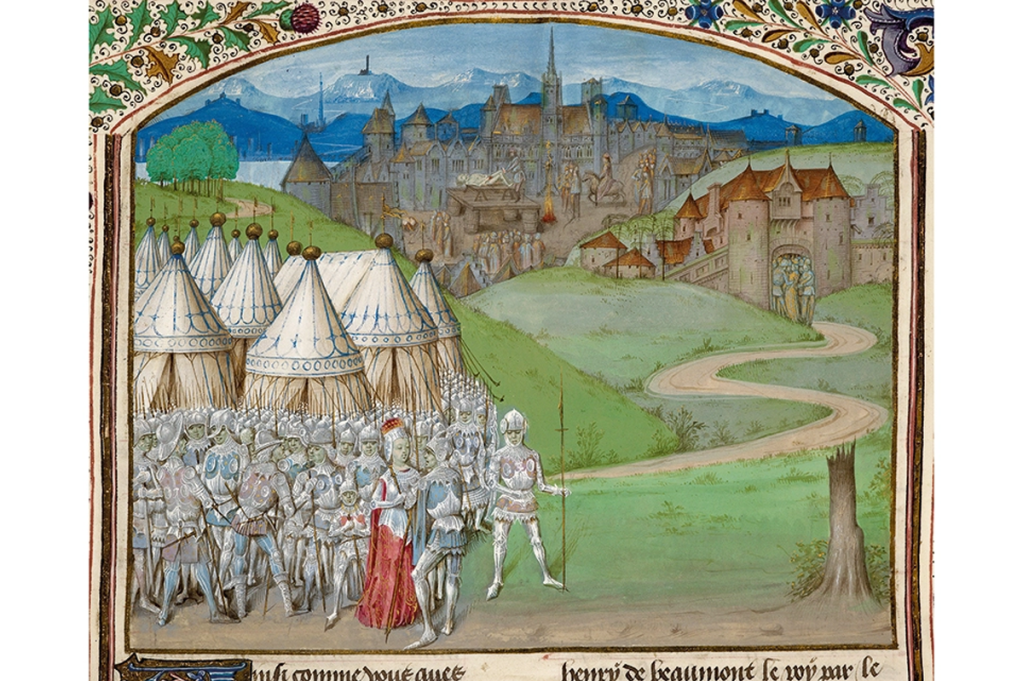The fourteenth century was “a bad time for humanity.” In the words of the Pulitzer prize-winning historian Barbara Tuchman:
If [those years] seemed full of brilliance and adventure to a few at the top, to most they were a succession of wayward dangers; of the three galloping evils, pillage, plague and taxes; of fierce and tragic conflicts, bizarre fates, capricious money, sorcery, betrayals, insurrections, murder, madness and the downfall of princes; of dwindling labor for the fields… and always the recurring black shadow of pestilence carrying its message of guilt and sin and the hostility of God.
It was a century when the four horsemen of St. John’s apocalyptic vision — Death, Famine, War and Conquest — became a miserable band of seven, joined by Taxes, Bad Government and Schism in the Church.
Alison Weir’s latest offering, the third volume of her study of the medieval queens of England, assesses the five women who were married to the four kings who ruled England during this period. The stories of the greedy and vengeful Isabella of France and her daughter-in-law, the saintly Philippa of Hainault, form the bulk of this volume. They are bookended by short chapters on Isabella’s aunt, Margaret of France, and the two queens of Richard II, Anne of Bohemia and Isabella of Valois.
Margaret was the wife of Edward I’s dotage (she was about twenty when they married in 1299, and Edward sixty). Queen for nine years, she was dominated by her ruthless husband and achieved little other than charitable works. Anne, beloved of Richard and the champion of many, was desperately and undeservedly unpopular, and I would have liked to see more on this cultivated and charismatic queen who was “the very embodiment of the international court culture.” Isabella of Valois, Richard’s second wife, was only twelve when her husband was murdered, and there is little to say other than that for Richard their marriage embodied his hopes of an end to the almost ceaseless round of war that marked the century.
The most interesting woman described, and the subject of a previous biography by Weir, is Isabella of France. The author devotes half the book to her. Isabella was the daughter of Philip IV, named “the fair” because of his beauty, not his character. She married Edward II in 1308, when she was about twelve and her husband twenty-three. Edward, however, was no Prince Charming. He neglected his bride, as he was in thrall to the most fascinating and irreverent favorite in English history, Piers Gaveston. Weir’s description of Gaveston’s farcical handling of Edward’s coronation alone is worth the price of the book. Edward’s submission to Gaveston upset his fractious nobility; for Gaveston, the mighty Gloucester was a “whoreson,” and Lancaster “the fiddler.” Gaveston eventually fell into their hands and was beheaded, and Edward spent the rest of his reign avenging him.
In a rollicking 200 pages, Weir describes Isabella’s turbulent history. During an ambassadorial mission to France, she accused two of her sisters-in-law of adultery with two brothers, based on spurious evidence. Philip believed her and imprisoned all three of his daughters-in-law. One was accused of simply knowing about the affair; the two supposed lovers were castrated and murdered. Just as interesting is what took place directly before Isabella’s accusation. The night before she arrived in Paris, her godfather, Jacques de Molay, grand master of the Knights Templar, was burned at the stake by her father. Regrettably, Weir makes no attempt to consider the psychological impact of de Molay’s death on Isabella, given that relationships with godparents in the Middle Ages were of far greater significance than today.
In 1325 Isabella, fearful of Edward’s new favorite, Hugh Despenser the younger, escaped to France with her eldest son, Prince Edward. She took a lover, the exiled Roger Mortimer, and prepared to invade England. And she did, in the only successful invasion since William the Conqueror’s 260 years earlier. Edward II was deposed (the first deposition in English history), Despenser suffered a traitor’s death and Edward III was crowned. Eventually finding his feet, he had Mortimer murdered in 1330 and Isabella spent the rest of her life in pious retirement. Whether or not she was involved in Edward II’s murder, we do not know. Some historians now believe he escaped. Isabella’s lasting legacy was the Hundred Years’ War between England and France: Edward III believed the French crown was his by right, as the only surviving grandson of Philip IV.
From the vengeful to the good, Isabella’s daughter-in-law, Philippa of Hainault, embodied all the queenly virtues — pious, beneficent and an intercessor extraordinaire. Indeed, Weir’s character sketches of all five women are engaging, her attention to detail and itineraries comprehensive. She is an excellent storyteller: descriptions are vivid and her knowledge of the sources is extensive.
However, it ultimately leaves the reader unsatisfied. The events these women lived through were seismic. Although Weir pays attention to the bad government that characterized the period, she glosses over the calamities that marked fourteenth-century England: the famines during Isabella’s time; the Black Death (given only four pages); and the Peasants’ Revolt (meriting a scant four lines). The fracture of the papal schism is barely mentioned. Some modern biographers focus too tightly on their subjects, and do them a disservice. Surely we want to read about their lives and their times and not just about how they ate and dressed while the peasants raged.
This article was originally published in The Spectator’s UK magazine. Subscribe to the World edition here.

























